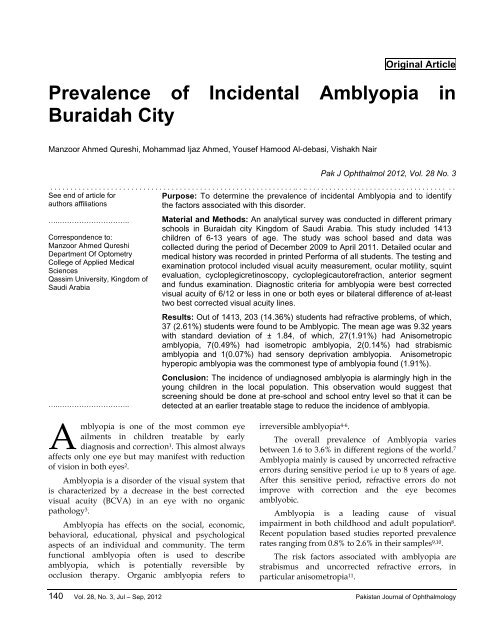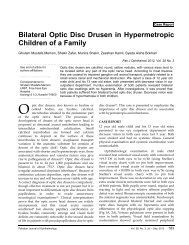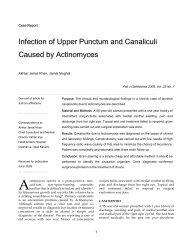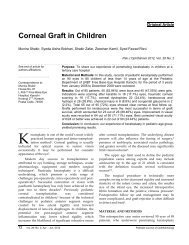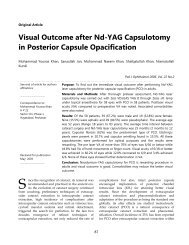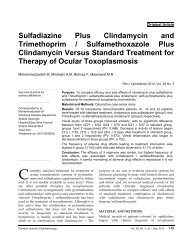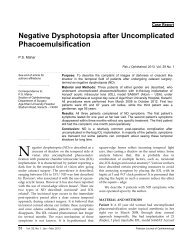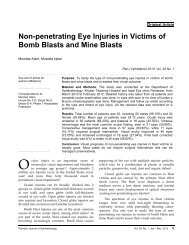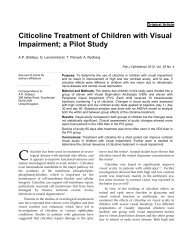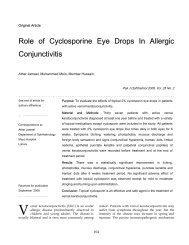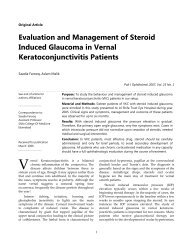7. Manzoor A Qureshi.pdf - Pakistan Journal of Ophthalmology
7. Manzoor A Qureshi.pdf - Pakistan Journal of Ophthalmology
7. Manzoor A Qureshi.pdf - Pakistan Journal of Ophthalmology
Create successful ePaper yourself
Turn your PDF publications into a flip-book with our unique Google optimized e-Paper software.
Original ArticlePrevalence <strong>of</strong> Incidental Amblyopia inBuraidah City<strong>Manzoor</strong> Ahmed <strong>Qureshi</strong>, Mohammad Ijaz Ahmed, Yousef Hamood Al-debasi, Vishakh NairPak J Ophthalmol 2012, Vol. 28 No. 3. . . . . . . . . . . . . . . . . . . . . . . . . . . . . . . . . . . . . . . . . . . . . . . . . . . . . . . . . . . . .. . .. . . . . . . . . . . . . . . . . . . . . . . . . . . . . . . . . . . . .See end <strong>of</strong> article forPurpose: To determine the prevalence <strong>of</strong> incidental Amblyopia and to identifyauthors affiliationsthe factors associated with this disorder.…..………………………..Correspondence to:<strong>Manzoor</strong> Ahmed <strong>Qureshi</strong>Department Of OptometryCollege <strong>of</strong> Applied MedicalSciencesQassim University, Kingdom <strong>of</strong>Saudi Arabia…..………………………..Material and Methods: An analytical survey was conducted in different primaryschools in Buraidah city Kingdom <strong>of</strong> Saudi Arabia. This study included 1413children <strong>of</strong> 6-13 years <strong>of</strong> age. The study was school based and data wascollected during the period <strong>of</strong> December 2009 to April 2011. Detailed ocular andmedical history was recorded in printed Performa <strong>of</strong> all students. The testing andexamination protocol included visual acuity measurement, ocular motility, squintevaluation, cycloplegicretinoscopy, cycloplegicautorefraction, anterior segmentand fundus examination. Diagnostic criteria for amblyopia were best correctedvisual acuity <strong>of</strong> 6/12 or less in one or both eyes or bilateral difference <strong>of</strong> at-leasttwo best corrected visual acuity lines.Results: Out <strong>of</strong> 1413, 203 (14.36%) students had refractive problems, <strong>of</strong> which,37 (2.61%) students were found to be Amblyopic. The mean age was 9.32 yearswith standard deviation <strong>of</strong> ± 1.84, <strong>of</strong> which, 27(1.91%) had Anisometropicamblyopia, 7(0.49%) had isometropic amblyopia, 2(0.14%) had strabismicamblyopia and 1(0.07%) had sensory deprivation amblyopia. Anisometropichyperopic amblyopia was the commonest type <strong>of</strong> amblyopia found (1.91%).Conclusion: The incidence <strong>of</strong> undiagnosed amblyopia is alarmingly high in theyoung children in the local population. This observation would suggest thatscreening should be done at pre-school and school entry level so that it can bedetected at an earlier treatable stage to reduce the incidence <strong>of</strong> amblyopia.Amblyopia is one <strong>of</strong> the most common eyeailments in children treatable by earlydiagnosis and correction 1 . This almost alwaysaffects only one eye but may manifest with reduction<strong>of</strong> vision in both eyes 2 .Amblyopia is a disorder <strong>of</strong> the visual system thatis characterized by a decrease in the best correctedvisual acuity (BCVA) in an eye with no organicpathology 3 .Amblyopia has effects on the social, economic,behavioral, educational, physical and psychologicalaspects <strong>of</strong> an individual and community. The termfunctional amblyopia <strong>of</strong>ten is used to describeamblyopia, which is potentially reversible byocclusion therapy. Organic amblyopia refers toirreversible amblyopia 4-6 .The overall prevalence <strong>of</strong> Amblyopia variesbetween 1.6 to 3.6% in different regions <strong>of</strong> the world. 7Amblyopia mainly is caused by uncorrected refractiveerrors during sensitive period i.e up to 8 years <strong>of</strong> age.After this sensitive period, refractive errors do notimprove with correction and the eye becomesamblyobic.Amblyopia is a leading cause <strong>of</strong> visualimpairment in both childhood and adult population 8 .Recent population based studies reported prevalencerates ranging from 0.8% to 2.6% in their samples 9,10 .The risk factors associated with amblyopia arestrabismus and uncorrected refractive errors, inparticular anisometropia 11 .140 Vol. 28, No. 3, Jul – Sep, 2012 <strong>Pakistan</strong> <strong>Journal</strong> <strong>of</strong> <strong>Ophthalmology</strong>
PREVALENCE OF INCIDENTAL AMBLYOPIA IN BURAIDAH CITYStudies have suggested that screening isassociated with an absolute reduction in prevalence <strong>of</strong>amblyopia between 0.9% to 1.6% 12 .The purpose <strong>of</strong> this study is to determine theprevalence <strong>of</strong> incidental Amblyopia and to identify thefactors associated with this disorder in our region.This study in Buraidah city had not beenconducted before.The various factors responsible for amblyopia asobserved in our study are shown in figure 2.Anisometropic hyperopic amblyopia was thecommonest type <strong>of</strong> amblyopia found (1.91%).MATERIAL AND METHODSIt was a prospective analytical survey <strong>of</strong> 7 differentprimary school in Buraidah city. In this survey a 1413students <strong>of</strong> 6-13 years <strong>of</strong> age were examined byqualified ophthalmologist, optometrist along with thehelp <strong>of</strong> optometry students <strong>of</strong> our college. The studywas school based and data was collected after theconsent <strong>of</strong> the school authority during the period <strong>of</strong>December 2009 to April 2011.Detailed ocular and medical history was recordedin printed Performa <strong>of</strong> all students. The testing andexamination protocol included visual acuitymeasurement, ocular motility, squint evaluation,cycloplegic retinoscopy, cycloplegic auto refractionand examination <strong>of</strong> anterior segment and fundus.Visual acuity was measured with snellen E- chart at 6meter, cover-uncover test and alternate cover test wereperformed both at 0.5 meter and 6.0 meter with andwithout glasses, the degree <strong>of</strong> Tropia was measuredusing the corneal light reflex, anterior segment wasexamined with binocular magnifying loupe.Cycloplegia was obtained after 2 cycles <strong>of</strong> 1 drop<strong>of</strong> 1% cyclopentolate hydrochloride and 1 drop <strong>of</strong> 1%tropicamide instilled 5 minutes apart after cornealanesthesia with 1% methocaine hydrochloride. Autorefractor was used to perform cycloplegic autorefraction.Fundus <strong>of</strong> every child was examined byophthalmoscope.Data entry and analysis was done in SPSS version1<strong>7.</strong>RESULTSOf the total number 1413 students, 203 (14.36%) hadrefractive problems, <strong>of</strong> which, 50 (24.63%) were in theage group 4-8 years, 55 (2<strong>7.</strong>09%) were in 9-10 years <strong>of</strong>age while 98 (48.27%) were between 11-13 years, asshown in table 1, <strong>of</strong> which, 37 (2.61%) students wereamblyopic, as shown in fig. 1 and table 2. The meanage was found to be 9.32 years with a standarddeviation <strong>of</strong> ± 1.84.DISCUSSIONAmblyopia is defined as a best corrected Snellenacuity <strong>of</strong> 20/40 or worse in either eye and /or an interocular difference <strong>of</strong> two Snellen lines or more 13 .It is one <strong>of</strong> the leading cause <strong>of</strong> acquiredmonocular visual impairment, with an overallprevalence <strong>of</strong> amblyopia varying between 1.6 to 3.6%in different regions <strong>of</strong> the world 7,14 .In our study, 14.36% had refractive errors, 2.61%were amblyopic. These finding were quite similar tothe observation <strong>of</strong> Awan, who found 3% <strong>of</strong>amblyopia, 15 while Pai have found 1.9% in theirsample 16 .In this study, Anisometropic amblyopia was thecommonest problem found (1.91%), and this isconsistent with the results <strong>of</strong> Shah M andKhan. 17 Studies have demonstrated that children withhigher magnitude <strong>of</strong> anisometropia had higherprevalence and greater depth <strong>of</strong> amblyopia 18 .In our cases <strong>of</strong> anisometropic amblyopiamajoritywere hyperopic. In actual fact, anisometropicamblyopia is more common in hyperopic withanisometropia than it is myopic anisometropia 19 .<strong>Pakistan</strong> <strong>Journal</strong> <strong>of</strong> <strong>Ophthalmology</strong> Vol. 28, No. 3, Jul – Sep, 2012 141
MANZOOR AHMED QURESHI, et al2.61%Amblyopia: 2.61% Others: 9<strong>7.</strong>39%93.39%Dr. Mohammad Ijaz AhmedDepartment <strong>of</strong> OptometryCollege <strong>of</strong> Applied Medical SciencesQassim University, Kingdom <strong>of</strong> Saudi ArabiaDr. Yousef Hamood Al-debasiDepartment <strong>of</strong> OptometryDean, College <strong>of</strong> Applied Medical SciencesQassim University, Kingdom <strong>of</strong> Saudi ArabiaDr. Vishakh NairDepartment <strong>of</strong> OptometryCollege <strong>of</strong> Applied Medical SciencesQassim University, Kingdom <strong>of</strong> Saudi ArabiaFig 1: Prevalance <strong>of</strong> Incidental Amblyopia0.94%0.14%0.07%1.91%Anisometropic Isometropic Strabismic SensoryFig 2: Distribution <strong>of</strong> amblyopiaThe prevalence rate <strong>of</strong> amblyopia among schoolchildren in Riyadh, Abha and Jeddah were 2.6%,1.9%,1.3% respectively, 20-22 our result were slightlyhigher when compared to these results. Rahi, Sapkota,and Drover showed the prevalence <strong>of</strong> Amblyopia was4.8%, 1.8% 4.7% respectively 23-25 .CONCLUSIONThe incidence <strong>of</strong> undiagnosed amblyopia isalarmingly high in the young children in the localpopulation. This observation suggest that screeningshould be done at pre-school and school entry level sothat it can be detected at an earlier treatable stage toreduce the incidence <strong>of</strong> amblyopia.Author’s affiliationDr. <strong>Manzoor</strong> Ahmed <strong>Qureshi</strong>Department <strong>of</strong> OptometryCollege <strong>of</strong> Applied Medical SciencesQassim University, Kingdom <strong>of</strong> Saudi ArabiaREFERENCE1. Stager DR. Amblyopia and the pediatrician.Paed ann. 1983; 12:574-84.2. Cooper J, Cooper R. All about amblyopia (lazy eye). 2001-2010.3. Von Noorden GK, Campos EC. Binocular vision and ocularmotility: theory and management <strong>of</strong> strabismus. 6th ed. St.Louis: Mosby. 2001; 246–<strong>7.</strong>4. American Academy <strong>of</strong> <strong>Ophthalmology</strong>. Amblyopia. In: Basicand Clinical Science Course: Pediatric <strong>Ophthalmology</strong> andStrabismus. 1997: 259-65.5. Kushner, BJ. Amblyopia. In: Nelson LB, ed. Harley's Pediatric<strong>Ophthalmology</strong>. 1998: 125-39.6. Von Noorden GK. Binocular Vision and Ocular Motility:Theory and Management. 1996; 216-54.<strong>7.</strong> Shafique MM, Naeemullah, Butt NH, et al. Incidence <strong>of</strong>Amblyopia in Strabismic population, Pak J Ophthalmol. 2007;23.8. Wang Y, Liang YB, Sun LP, et al. Prevalence and causes <strong>of</strong>amblyopia in a rural adult population <strong>of</strong> Chinese the HandanEye Study. <strong>Ophthalmology</strong>. 2011; 118: 279-83.9. Friedman DS, Repka MX, Katz J, et al. Prevalence <strong>of</strong>amblyopia and strabismus in white and African Americanchildren aged 6 through 71 months the Baltimore Pediatric EyeDisease Study. <strong>Ophthalmology</strong>. 2009; 116: 2128-34.10. Chia A, Dirani M, Chan YH, et al. Prevalence <strong>of</strong> amblyopiaand strabismus in young singaporeanchinese children. InvestOphthalmol Vis Sci. 2010; 51: 3411-<strong>7.</strong>11. American Academy <strong>of</strong> Ophthalmologists Amblyopia is amedical condition. AAO; 2006.12. Schmucker C, Grosselfinger R, Riemsma R, et al.Effectiveness <strong>of</strong> screening preschool children for amblyopia: asystematic review. BMC Ophthalmol. 2009; 9: 3.13. Douglas, K Newman, Miranda M. East. Pre School Vision theScreening: Negative Predictive Value for Amblyopia. Br J.Ophthalmol. 1999; 83: 676-9.14. Attebo K, Mitchell P, Cumming R, et al. Prevalence andcauses <strong>of</strong> amblyopia in an adult population. <strong>Ophthalmology</strong>.1998; 105: 154–9.15. Awan MA, Ahmad I, Khan AA. Prevalence <strong>of</strong> Amblyopiaamong Government Middle School Children in City <strong>of</strong> Lahore,<strong>Pakistan</strong>. IJAVMS. 2010; 4: 41-6.16. Pai AS, Rose KA, Leone JF, et al. Amblyopia prevalence andrisk factors in Australian preschool children. <strong>Ophthalmology</strong>.2012; 119: 138-44.1<strong>7.</strong> Shah M, Khan MT, Khan MD, et al. Clinical pr<strong>of</strong>ile <strong>of</strong>amblyopia in <strong>Pakistan</strong> children age 3-14 years. Coll Physic SurgPak. 2005; 15: 353-<strong>7.</strong>142 Vol. 28, No. 3, Jul – Sep, 2012 <strong>Pakistan</strong> <strong>Journal</strong> <strong>of</strong> <strong>Ophthalmology</strong>
PREVALENCE OF INCIDENTAL AMBLYOPIA IN BURAIDAH CITY18. Leon A, Donahue SP, Morrison DG. The age-dependent effect<strong>of</strong> anisometropia magnitude on anisometropic amblyopiaseverity. J AAPOS. 2008; 12: 150-6.19. Weakley DR. The association between anisometropia,amblyopia, and binocularity in the absence <strong>of</strong> strabismus.Trans Am Ophthalmol Soc. 1999; 97: 987-1021.20. Al-Assaf A, Fatani R. Vision screening <strong>of</strong> preschool children inRiyadh. Saudi J <strong>of</strong> <strong>Ophthalmology</strong>. 1994; 8: 9-14.21. Abolfotouh M, Aheem Y. Ocular Disorders Among schoolboys in a high altitude area <strong>of</strong> Saudi Arabia. Saudi J <strong>of</strong><strong>Ophthalmology</strong>. 1994; 8: 20-4.22. Bardisi WM, Bin Sadiq BM. Vision screening <strong>of</strong> preschoolchildren in Jeddah, Saudi Arabia. Saudi Med J. 2002; 23: 445-9.23. Rahi JS, Cumberland PM, Peckham CS. Does Amblyopiaaffect educational, health and social outcomes? BMJ. 2006; 8:820-5.24. Sapkota YD, Adhikari BN, Pokharel GP, et al. The prevalence<strong>of</strong> visual impairment in school children <strong>of</strong> upper middlesocioeconomic status in Kathmandu. Ophthalmic Epidemiol.2008; 15: 17-23.25. Drover JR, Kean PG, Courage ML, et al. Prevalence <strong>of</strong>Amblyopia and other vision disorders in young Newland andLabrador children. Can 2008; 43: 89-94.<strong>Pakistan</strong> <strong>Journal</strong> <strong>of</strong> <strong>Ophthalmology</strong> Vol. 28, No. 3, Jul – Sep, 2012 143


